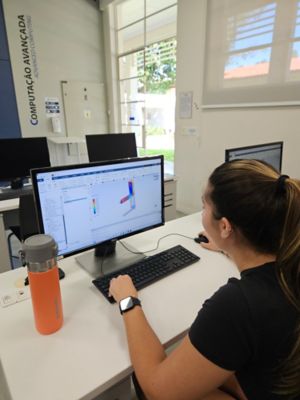The complicated nature of fluid flow makes modeling it on a computer inherently difficult. Multiphysics interactions, nonlinearity, and unsteadiness are some of the complexities that make analyzing fluids so challenging.
Multiphysics interactions: Fluids don’t usually flow in isolation: they flow within, through, and around structures. Think about trees moving in the wind. When the tree moves it changes the wind, and the wind changes the tree. This coupled problem of fluid interacting with a structure requires a multiphysics approach to modeling.
Ansys CFD software, such as Fluent and LS-Dyna, can solve fluid-structure interaction problems like this (sometimes coupling with a structural mechanics solver, like Ansys Mechanical). And even when considering the fluid in isolation, many real-world scenarios involve multiple fluids (e.g., air bubbles rising through water) and/or changes to the chemical composition of a fluid through reactions (e.g., combusting flow inside an aircraft engine or the chemical reactions occurring in your car’s battery). Ansys Fluent is particularly well-suited to model these situations.
Nonlinearity: In fluid dynamics, this property of the governing physical equations means that the fluid interacts with itself. Most flows of engineering interest are turbulent in nature. Turbulence is one example of a nonlinearity in fluid dynamics, since turbulence affects other quantities like heat transfer and momentum, which in turn affect turbulence. By turbulence (yes, like what the captain is talking about on the airplane), we mean that the flow is random, chaotic, and non-deterministic.
This randomness is why a key component of computational fluid dynamics is the word “computational.” Because of nonlinearity and turbulence, there’s no pencil-to-paper way to solve these equations. It must be done on a computer (save for a few simple laminar flows with low dimensionality). Even then, the answer to a CFD problem is not a solution—it’s the computer’s calculated solution after turning a bunch of calculus into algebra.
Unsteadiness: An inherent feature of turbulence is unsteadiness. This means that the flow quantities at any fixed point in space change with time. If this unsteadiness is significant (e.g., your car driving on the highway), a highly accurate simulation requires a time-resolved solution, which greatly increases the cost.
The widespread phenomenon of turbulence has stumped scientists and engineers for generations. It is so complicated that Nobel Prize-winning theoretical physicist Richard Feynman called it “the most important unsolved problem of classical physics.”. While CFD doesn’t solve the problem of turbulence from a mathematical perspective, it allows engineers to create models that account for the effects of turbulence in their designs.



No comments:
Post a Comment